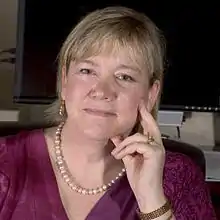Leona D. Samson
Leona D. Samson is the Uncas and Helen Whitaker Professor and American Cancer Society Research Professor of Biological Engineering at the Massachusetts Institute of Technology, where she served as the Director of the Center for Environmental Health Sciences from 2001 - 2012.[1][2] Before her professorship at MIT, she held a professorship at the Harvard School of Public Health.[3] She is on the editorial board of the journal DNA Repair.[4] Her research interests focus on "methods for measuring DNA repair capacity (DRC) in human cells", research the National Institute of Health recognized as pioneering in her field, for which the NIH granted her the National Institutes of Health Director's Pioneer Award.[2][5]
Leona D. Samson | |
|---|---|
 | |
| Born | August 29, 1952 |
| Alma mater | University of Aberdeen and University College London |
| Known for | Biochemistry, genetics, systems biology |
| Children | 1 |
| Scientific career | |
| Fields | Biological Engineering, Biology |
| Institutions | Massachusetts Institute of Technology |
Education and career
Samson received her Bachelor of Science degree in Biochemistry from the University of Aberdeen in 1974.[3] She then went on to complete her PhD in Molecular Biology from the University College London in 1978.[2] She holds two endowed professorships at MIT, one being the Uncas and Helen Whitaker Professor and the other is the American Cancer Society Research Professor in the department of Bioengineering.[1] She is also an Adjunct Professor of Toxicology at Harvard University.[3] In 2001 she became the Director of the Center for Environmental Health Sciences at MIT.[3] She leads a lab at MIT named the Samson Group, focusing on researching human DNA repair and methods by which one can measure DNA repair capacity.[6] She was recognized by the NIH for her work in 2009, when she was awarded the National Institutes of Health Director's Pioneer Award, a funded grant awarded to "[support] individual scientists of exceptional creativity, who propose pioneering – and possibly transforming approaches – to major challenges in biomedical and behavioral research."[7] Since 2007 she has been a member of the American Association for the Advancement of Science, "the world's largest general scientific society".[8]
Research area
Samson specializes in human DNA repair.[1][9] Specifically, her lab's goal is to "understand the biology, the biochemistry, and the genetics of numerous DNA repair pathways that act upon DNA alkylation damage."[1] This is applicable to human cancer research, because alkylating agents are used extensively in chemotherapy and other cancer treatments.[1] She is researching "how eukaryotic cells respond to alkylating agents."[1] Alkylating agents are drugs which work by replacing a hydrogen with an alkyl group, with the end result being DNA damage.[10][11] Alkylating agents inhibit protein synthesis and damages rapidly dividing cells, among which cancer cells are primarily affected because they divide so rapidly.[12] She measures cells' ability to resist the toxicity caused by DNA-damaging agents, like alkylating agents.[2]
Publications
Most of Samson's contemporary publications are written about alkylating agents in particular or about DNA repair pathways.[13] One of her most-cited articles, "Global response of Saccharomyces cerevisiae to an alkylating agent", measures the gene transcript levels of a yeast named Saccharomyces cerevisiae.[14] Another highly cited article, also about Saccharomyces cerevisiae, was published in 2000 and entitled "Regulatory Networks Revealed by Transcriptional Profiling of Damaged Saccharomyces cerevisiae Cells: Rpn4 Links Base Excision Repair with Proteasomes."[15] This paper finds that the transcription and repair of certain genes in the yeast are regulated by the proteasome-associated protein Rpn4.[15] Samson is also an Associate Editor of the journal DNA Repair, a "leading scientific journal that publishes research on cellular responses to DNA damage."[16]
Awards
- American Cancer Society Scholar Award (1985)
- American Cancer Society Faculty Research Award (1987)
- Burroughs Wellcome Toxicology Scholar Award (1993)
- AACR Women in Cancer Research Award (2000)
- Environmental Mutagen Society Annual Award for Research Excellence (2001)
- American Cancer Society Research Professor (2001)
- Elected member of the Institute of Medicine (IOM) of the National *Academies of Science (NAS) (2003)
- Elected President of the Environmental Mutagen Society (2004)
- Elected Fellow of the American Association for the Advancement of Science (AAAS) (2007)
- NIH Director's Pioneer Award (2009)
- Senior Scholar Award from the Ellison Medical Foundation (2012)
- Fellow of the Radcliffe Institute for Advanced Study (2014–15)
Personal life
Samson married David Hunter, the Dean for Academic Affairs and current Acting Dean of the Faculty at the Harvard School of Public Health, on August 5, 1989. They adopted their daughter, Claire, in 1994.
References
- "Leona D. Samson". MIT. Retrieved 2013-10-09.
- "2009 Pioneer Award Recipients". National Institute of Health. Retrieved 2013-10-09.
- "Leona D. Samson". videolectures.net. Retrieved 2013-10-09.
- "Leona D. Samson". Elsevier. Retrieved 2013-10-09.
- "Developing Improved Methods to Measure Human DNA Repair Capacity" (PDF). NIH. Retrieved 2013-10-09.
- "Summary of Current Research". Samson Group. Retrieved 2013-10-09.
- "NIH Directors Pioneer Award Program". NIH. Retrieved 2013-10-09.
- "AAAS". AAAS. Retrieved 2013-10-23.
- Samson, Leona. "publications". PubMed.
- "alkylating agents". Miriam-Webster Dictionary. Retrieved 2013-10-23.
- "alkylating agents". thefreedictionary.com. Retrieved 2013-10-23.
- "Alkylating Agents". NIH. Retrieved 2013-10-10.
- "Leona D. Samson". Microsoft Academic Search. Retrieved 2013-10-10.
- "Global response of Saccharomyces cerevisiae to an alkylating agent". Proceedings of the National Academy of Sciences. Retrieved 2013-10-10.
- "Regulatory Networks Revealed by Transcriptional Profiling of Damaged Saccharomyces cerevisiae Cells: Rpn4 Links Base Excision Repair with Proteasomes". Molecular and Cell Biology. Retrieved 2013-10-10.
- "Wilson named editor-in-chief of DNA Repair". National Institute of Environmental Health Services. Retrieved 2013-10-10.
